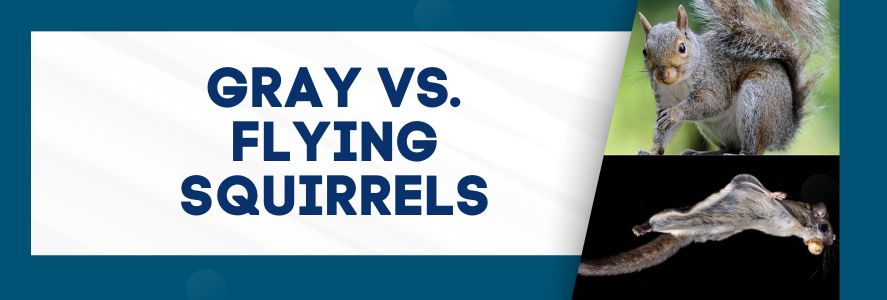Gray vs. Flying Squirrels: How to Tell Which One You’re Dealing With

Attic spaces often provide a perfect home for squirrels in Richmond, as they are safe, warm, and secluded. Attic spaces offer protection from both predators and the elements, making them a perfect place for squirrels to settle down. There are two main types of squirrels that will get inside your attic in Richmond: the Eastern Gray Squirrel and the Southern Flying Squirrel. Determining which squirrel species is invading your attic is crucial to understanding how to remove them, as both species require their own methods and techniques.
Physical Differences
The Eastern Gray Squirrel has a body roughly 9-12 inches in length, not including their distinctive bushy tail. As their name suggests, their fur is gray with a white underside. These squirrels are more active during the day, and you will often see them zipping around yards, scurrying across fences and leaping from tree to tree.
The Southern Flying Squirrel is smaller, about 8-10 inches long, including their tail. The flying squirrel’s fur is a soft grayish-brown, with a white belly. Flying squirrels are named for their skin flaps (patagium) that allow them to glide on the air, giving them the appearance of flight. Flying squirrels are nocturnal, often unseen but you will hear them at night if they have made their way indoors.
Signs You’re Dealing with Gray Squirrels
When Eastern Gray Squirrels have invaded your attic, you will hear them scampering and scurrying around up there during the daytime. You are also more likely to see them outside during the day, either in your yard or on your roof. You might also spot entry points on roof edges or soffits that have been chewed open by squirrels. If you go into the attic space, you might see visible nests made out of leaves, twigs, and insulation.
Signs You’re Dealing with Flying Squirrels
Southern Flying Squirrels are nocturnal, meaning you will hear their scratching and scampering sounds more often at night, which can be a serious nuisance when you are trying to sleep. Flying squirrels have their droppings clustered together in specific attic spots. Flying squirrels live together in groups, so you might notice a strong ammonia-like odor from communal nesting. Flying squirrel entry points are tiny, as they can fit into your attic through a hole the size of a quarter. Therefore, locating flying squirrel entry points isn’t as easy as locating the larger holes chewed by Eastern Gray Squirrels.
Why Identification Matters
Identifying squirrels properly matters because it affects the methods used for removal. Because Eastern Grey Squirrels and Southern Flying Squirrels are active at different times, the timing of their removal depends on which species is active inside your attic. The exclusion strategies also differ, as flying squirrels require sealing even the tiniest gaps, as they can fit in through almost anything. It also goes both ways, if you are unsure what type of squirrel you have in your attic, the type of damage can indicate which species you have.
What to Do If You Suspect Squirrels
If you suspect squirrels inside your attic space, don’t try to remove them yourself. Squirrels are wild animals that can lash out with their claws and teeth, and they can also spread harmful diseases like leptospirosis and tularemia. Don’t attempt to perform exclusion work yourself, as you might accidentally trap the squirrels or their babies inside the attic space.
Instead, the best thing to do if you suspect squirrels in your attic is to contact a licensed wildlife removal professional for an inspection. A wildlife technician has the tools, training, and expertise to locate squirrel infestations and their entry points, then determine the cost to trap and remove the squirrels from the attic space.
Prevention Tips for Both Species
There are a few steps you can take to prevent squirrels from getting inside your attic space in Richmond. Trim tree branches within 8-10 feet from the roofline, as gray squirrels can leap to the roof from trees and flying squirrels can glide there. Installing chimney caps and vent covers removes the easiest, most obvious access points for squirrels to get inside your home. Sealing roof gaps and soffit damage properly can also make it significantly difficult for gray squirrels and flying squirrels to break into your attic. Removing bird feeders, cleaning up fallen nuts, and removing other easy food sources from your yard can make your property less hospitable to squirrels.
Best Squirrel Removal Services in Richmond, VA
Knowing which squirrel species has invaded your attic space can save you time and money. Critter Authority can also help. We offer the best squirrel removal services in Richmond, VA and the surrounding areas. Our team starts with a FREE inspection, before we provide you with an estimated cost of removal. Then, we begin trapping and excluding squirrels from your attic. After all the squirrels are gone, we seal off the attic and remove their droppings, so it’s like they were never here. Critter Authority can also remove your soiled insulation, clean the area, and replace the insulation with newer, high-effective material. Contact our team to get started today with a FREE estimate at (804) 492-2804!
